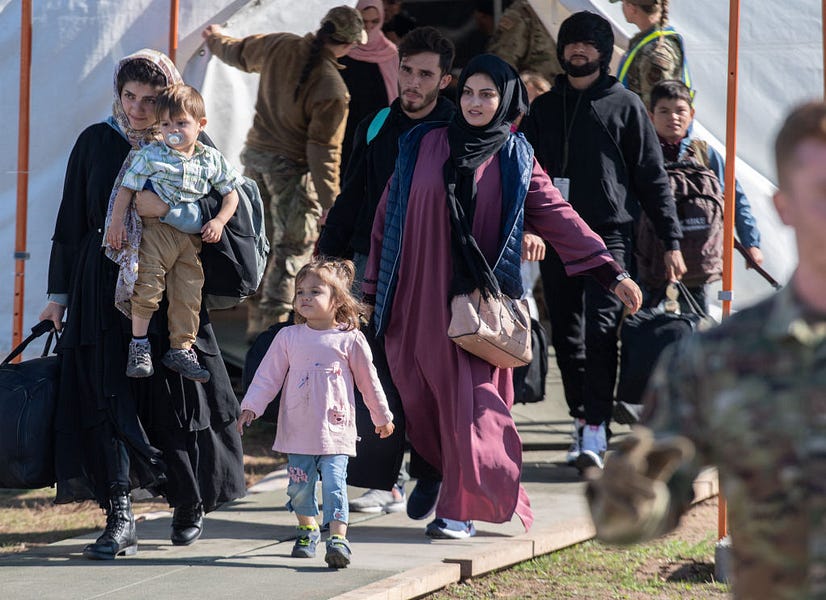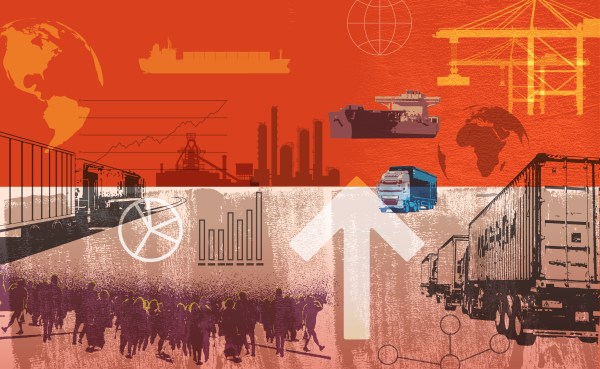Hosai Barakzay is no stranger to harrowing experiences. Through her work for the U.S. mission in Afghanistan, Barakzay traveled to each of her home country’s 34 provinces—including remote and impoverished areas—to monitor often overcrowded and under-funded facilities like prisons and children’s shelters. But in the days following the Taliban’s takeover of Kabul last August, Barakzay and her parents’ efforts to depart the country and evade retaliation without assistance from the U.S. government surpassed anything she had witnessed in the line of duty.
“It was unimaginable,” Barakzay, 23, said of her family’s first attempt to reach the guarded perimeter of Hamid Karzai International Airport. “All roads were blocked. People were in so much despair … our parents had very bad experiences of living under the Taliban government.”
Despite their approval by the U.S. State Department for the Priority 2 refugee program created to relocate at-risk Afghans, Barakzay’s mother and father were left behind and remain in hiding in Afghanistan. Barakzay—who was eligible for a special-immigrant visa (SIV)—was eventually able to escape on the final day of the U.S. military’s evacuation through the intervention of her Bangladesh-based university.
For Mansoora Sharifi, one of Barakzay’s travel companions and a member of the historically persecuted Hazara ethnic minority group, the evacuation itself unfolded in a nightmare-like, days-long saga. When Taliban fighters took over Kabul, it took Sharifi four hours to get from her office to her home—a trip that normally takes a half-hour—due to the chaos on the streets. As she sat in a car with her co-workers, she felt as if “I had just seen this kind of situation in a zombie movie. People are running, crashing their cars, [everyone is] scared.”
Even though she had the right paperwork, it took Sharifi multiple attempts to leave the country. During these attempts, she witnessed Taliban fighters beating civilians and firing guns in the air near people’s heads. At one point outside the gates a soldier harassed students: “Girls should be home. Why are you leaving the country? You want to go to a foreign country to be a sex slave for them?”
On her third try, Sharifi finally got on a plane with a group of other female students. But touching down in the United States was just the beginning of Barakzay and Sharifi’s ongoing endeavor to regain some semblance of normalcy.
With an influx of more than 76,000 Afghans arriving to American communities across nearly all 50 states, the nonprofits, community centers, and local and federal government programs tasked with their arrival have struggled to keep up, leaving many families and individuals in a state of limbo.
“The crisis extends far past the borders of Afghanistan,” said Adam DeMarco, a military veteran who co-founded Allied Airlift 21 last August to assist with the evacuation effort. Plenty of uncertainties surround the government’s plan to integrate Afghan allies on U.S. soil, he told The Dispatch. But the Biden administration’s bungling of the evacuation process has not inspired confidence in its resettlement plans. “I’m absolutely appalled at what has and is transpiring, and specifically how we are treating these people, our allies and partners, who have served with us for over 20 years,” he said. “Right now this entire situation is just f—ed.”
As of Monday, approximately 11,000 newcomers remained at five military installations, a Pentagon official told The Dispatch. A nationwide rental shortage has exacerbated the difficulty of relocating the remaining refugees.
Further complicating the resettlement process are the different statuses the government has granted to different Afghan arrivals, which in turn confer different benefits to recipients. “In the case of the most arrivals from Afghanistan, the vast majority of the people who were evacuated and are now coming off of military bases here in the United States have been given humanitarian parole status,” said Stephen Carattini, the president and CEO of Arlington Catholic Charities, which acts as a local resettlement agency in northern Virginia.
Humanitarian parole extends temporary lawful permanent status to recipients, according to the U.S. Citizenship and Immigration Services (USCIS.) The status is typically used to let noncitizens into the states for an emergency, time-limited circumstance, such as to visit an ill or dying relative. In 2020, the USCIS received 1,500 applicants for humanitarian parole. Since the U.S. withdrawal from Afghanistan, the agency has received more than 35,0000 following a directive by Department of Homeland Security Secretary Alejandro Mayorkas.
The Dispatch has previously covered the general screening process for SIV applicants, which is often a years-long process. Humanitarian parole is a separate process. In the case of newly arrived Afghans, parolees were processed at Kabul’s Hamid Karzai airport before flying to military bases in third countries, where they underwent rounds of medical and security screenings. The Department of Homeland security conducts the vetting, which includes gathering biometric data and checking law enforcement and intelligence agency watchlists.
Parolees can stay in the United States for two years and pursue more permanent means of citizenship by applying for asylum or another refugee status, such as an SIV or Priority 2 designation.
But Axios and other outlets have reported that the Biden administration has begun to issue its first denials of humanitarian parole to Afghan evacuees in recent weeks. The USCIS website currently notes it is “unable to complete processing of your parole request while you are in Afghanistan because the U.S. Embassy in Kabul is closed and all normal consular services in Afghanistan have been suspended.”
For three months last fall, Barakzay and Sharifi resided in rural Wisconsin’s Fort McCoy military base, the country’s most populated transit point with more than 13,000 Afghan refugees at its peak. Barakzay described the experience as “a nightmare,” between cramped conditions, cold weather, and limited access to medical care. In several instances, Barakzay told The Dispatch, women—particularly older women—fashioned abayas out of bedsheets for want of culturally appropriate clothing.
The two women have since relocated to Utah, but are ineligible for government housing aid and benefits because of their decision to depart from the military base after months of bureaucratic stagnation.
Similarly to other government-funded social services programs, the bulk of refugee resettlement falls to nine non-governmental partners, many of which are faith-based. The State Department determines who goes where, and, from there, state governments largely take over—contracting and distributing funding to 290 local affiliates of the nine umbrella organizations.
The local resettlement agency in Utah has yet to process Barakzay’s Social Security card, leaving her unable to apply for jobs or graduate degree programs. Sharifi also hopes to finish her education in America but worries that getting a scholarship will be impossible. SkilledSOS, a Utah-based nonprofit, is among the independent organizations assisting newly arrived Afghan refugees such as Barakzay and Sharifi in finding work and schooling.
“We already lost so much time, like three months in the camp. And other refugee families are still staying in a hotel. They are not able to find housing for them,” Barakzay said, adding that finding community support independent of social programs was a more practical option for her than Afghan families who don’t speak English.
Refugee resettlement infrastructure around took a severe hit during the four years of the Trump administration, which lowered the cap on refugee admissions each year, leading to shrinking funding and downsizing for many relief agencies. So they were ill-equipped to meet the sudden influx of refugees when the Taliban took over Afghanistan last summer.
“Resettlement infrastructure is coming off of four years where it was decimated. We had more than 100 offices across the network that were closed,” Krish O’Mara Vignarajah, president and CEO of Lutheran Immigration Refugee Services, told PBS. “We are rebuilding at a time when tens of thousands are coming and need our help.”
Catholic Charities of the Archdiocese of Oklahoma City, the only official refugee resettlement agency in the state, expanded its full-time staff of five to more than 25 after Oklahoma agreed to accept 1,800 Afghan refugees. Through state grants and private fundraising, the organization works to provide temporary and permanent housing, schooling, food, clothing, medical care, transportation, and other living expenses.
“One of the best parts of what’s been happening is the outpouring of support from the community,” Jessi Riesenberg, the agency’s senior director of development and outreach, told The Dispatch. “We have had hundreds of people, church groups, community groups, friend groups, and family units who have stepped up to say we really want to help with this.”
Many of the new arrivals are trying to integrate into American society while worrying about family and friends left behind in the hasty U.S. withdrawal.
“The challenge for most is that, not only was it the traumatic departure and the speed of the departure which didn’t allow them to say their goodbyes or even necessarily get their affairs in order, but they also left family behind,” Carattini said. “The thing that we hear the most often is their anxiety in concern, not just for themselves starting over, but for their loved ones who remained back in Afghanistan.”
Sharifi, whose brothers are uniquely at-risk in Taliban-occupied Afghanistan for their work with U.S.-affiliated companies, has suffered post-traumatic stress since her departure from Afghanistan. She described the nightmares she experienced while living at Fort McCoy: “Every night I dream about [the] Taliban, that they are coming to our home. They tie my brother’s hands, they hold my sisters and my mom and dad are crying. So every night those kinds of nightmares come in my dreams … all my neighbors are being killed by Taliban and I am there and I’m witnessing but I can’t do anything.” She’d wake up, covered in sweat.
Now, she said, “everything [has] collapsed.”
“I was supposed to graduate in May ‘22. I was so hopeful and I was feeling I will have a bright future in Afghanistan,” she said. “Not only me, all the young generation became hopeful for a better future in Afghanistan … they [were] trying to bring new things into the country, to work for better country, better education, better life.”
Being aware of context is important as Americans seek to welcome Afghan refugees into communities across the country, Riesenberg explained. “We as Americans have this mentality that this is the best place on earth—why would they not want to live here? But the reality is that these Afghan refugees had lives and families in their place of birth,” Riesenberg said. “They’d much rather be in a safe, thriving Afghanistan.”







Please note that we at The Dispatch hold ourselves, our work, and our commenters to a higher standard than other places on the internet. We welcome comments that foster genuine debate or discussion—including comments critical of us or our work—but responses that include ad hominem attacks on fellow Dispatch members or are intended to stoke fear and anger may be moderated.
With your membership, you only have the ability to comment on The Morning Dispatch articles. Consider upgrading to join the conversation everywhere.